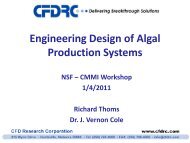Controlled nanostructure and high loading of single-walled carbon ...
Controlled nanostructure and high loading of single-walled carbon ...
Controlled nanostructure and high loading of single-walled carbon ...
Create successful ePaper yourself
Turn your PDF publications into a flip-book with our unique Google optimized e-Paper software.
Nanotechnology 18 (2007) 095708SWanget al(a)(b)Figure 9. SEM images <strong>of</strong> SWNTs/PC composite fracture surfaces: (a) 2 wt% SWNTs <strong>loading</strong> casting sample; (b) 20 wt% SWNT <strong>loading</strong>buckypaper composite sample.Table 1. Modulus <strong>of</strong> CNTs/PC composites.Tubes <strong>loading</strong> by weight Storage modulus ReferredApproaches (%) (GPa) literatureBuckypaper SWNT: 20 6.2 This studyimpregnationMelting mixing MWNT: 1.5–15 ∼1.0 [15]Solution casting SWNT: 0.05–0.25 1.6–2.1 [3]Functionalized 2.35–2.52 [16]SWNT: 0.5–2MWNT: 5–20 1.1–2.42 [17, 18]Figure 8 shows the storage modulus <strong>of</strong> a pristine poly<strong>carbon</strong>ateis 1.8 GPa. Comparatively, the modulus <strong>of</strong> 2 wt% SWNT reinforcedpoly<strong>carbon</strong>ate (produced by solution casting method)increased to 2.4 GPa, a factor <strong>of</strong> 1.3 increment, <strong>and</strong> the modulus<strong>of</strong> 20 wt% SWNT-buckypaper reinforced poly<strong>carbon</strong>atejumped to 6.2 GPa, a factor <strong>of</strong> 3.4 increment. Obviously,the controlled <strong>nanostructure</strong> <strong>and</strong> <strong>high</strong> <strong>loading</strong> contributed tothe improved mechanical performance in the thermoplasticnanocomposites. Table 1 lists the storage modulus <strong>of</strong> CNTsreinforced poly<strong>carbon</strong>ate composites prepared from conventionalmethods in the reported literature. It can be seen that thebuckypaper/PC solution infiltration method achieved a <strong>high</strong>ermechanical property.The fracture surfaces <strong>of</strong> the SWNT-buckypaper/PCcomposites with 20 wt% tube <strong>loading</strong> were characterizedwith SEM, as shown in figure 9. The dimpled morphologyin the fracture surface indicates that considerable level <strong>of</strong>localized plastic deformation occurred to prevent formationor coalescence <strong>of</strong> microvoids, which can potentially lead tocrack propagation. This type <strong>of</strong> dimple fracture suggests thatmechanical properties <strong>of</strong> SWNT-buckypaper/PC compositeswere enhanced due to the well-dispersed SWNT network.Theoretical modulus <strong>of</strong> PC/SWNTs composite wasestimated by the Cox–Krench model [11]. Computationresults showed that the elastic modulus <strong>of</strong> nanocompositeswas 3.7 GPa for 2 wt% tube <strong>loading</strong> <strong>and</strong> 64.25 GPa for20 wt% <strong>loading</strong>. These theoretical values are much <strong>high</strong>erthan the experimental measurements. Theoretical calculationmay overestimate the modulus by using individual nanotubemodulus rather than bundle modulus, which have a much lowermodulus [19]. It is very difficult to achieve the individual tubedispersion in the experiments. Another possible major reason<strong>of</strong> this mismatch may arise from the weak interfacial bonding,a consequence <strong>of</strong> the smooth <strong>and</strong> chemically inactive surface<strong>of</strong> SWNTs. The weak interfacial bonding significantly reducedthe efficiency <strong>of</strong> the load transfer <strong>and</strong> resulted in low modulusin the experiments. In addition, the low experimental valuescould also stem from the short SWNT lengths, which were547 nm on average [20]. Therefore, even though this paperhas demonstrated an effective method to fabricate <strong>high</strong>-<strong>loading</strong>thermoplastics nanocomposites with controlled <strong>nanostructure</strong>,much more efforts, such as nanotube functionalization, areneeded in order to realize the full potentials <strong>of</strong> <strong>carbon</strong>nanotubes in the composite applications.4. ConclusionsAn effective approach was presented to acquire good dispersion<strong>and</strong> <strong>high</strong> <strong>loading</strong> <strong>of</strong> nanotubes in the fabrication <strong>of</strong>SWNTs/PC composites, which is very difficult using conventionalmanufacturing techniques. A controlled <strong>nanostructure</strong> <strong>of</strong>SWNTs/PC composite can be achieved through impregnatingpreformed SWNT networks or buckypaper with PC solution.This method can also be extended to other suitable thermoplasticresins for <strong>high</strong> nanotube <strong>loading</strong> nanocomposites. Thecomparison between experimental value <strong>and</strong> theoretical predictionindicates that functionalization is necessary to improveload transfer efficiency. In addition, this method also makes itfeasible to fabricate aligned nanocomposites if buckypaper iscomposed <strong>of</strong> aligned nanotubes.6



